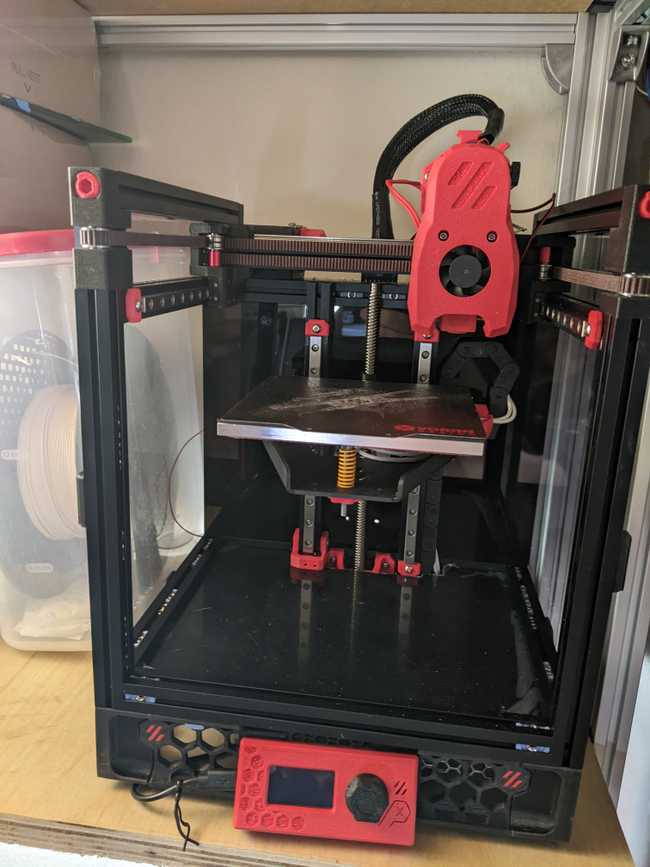Prelude to first print…
- I washed the Formbot-provided flexplate with dish soap because I figure if I’m going to screw up a flexplate, it’s the right one to screw up. As I’m washing the smooth side, I feel something coming off. Okay, that’s not good. But, no, oops, it looks like that was a protective coating to keep the smooth side smooth.
- I set the Z-endstop position with an eye towards seeing where exactly the Kirigami bed interfered with the screw for the thermal fuse and it’s definately eating up a few mm of travel.
- Overall.. the bed-leveling process seems better with Klipper and the
BED_SCREWS_ADJUSTmacro. What I’m really interested is in how much the bed drifts over time, of course. - Did the PID tune for both the hot-end and the bed. One thing I’m thinking about is having the
klipper.cfgbe a skeleton file so that Ansible could put it in place and not need to touch the config settings saved, because right now, Ansible will overwrite the saved settings for virtual endstops, PID tuning, and Z-endstop position. - Did the extruder tuning, the default is pretty close to fully right, just a little bit off.
First print
I decided, before getting too far into things, that I’d at least print a proper Voron calibration cube. So I’m using the SuperSlicer provided profile with everything left to the defaults. And since most of what I’ve got is PETG I figured I’d just print everything with that, for better or worse?
Seems actually pretty good considering that I need to actually properly calibrate things, LOL.
Spoolman
🎶Well, all my friends are ABS
(All my friends are black and red)
Spoolman
And all my friends are S.R.E’s
(They beat the software with their hands)
Spoolman
Oh, hmm
Spoolman, come together with your hands
Save me, I’m together with your plan 🎶
(With apologies to Soundgarden)
This is something I’m super-cheerful about being able to run on my NUC instead of on the Pi. With OctoPrint, you’ve got a bunch of functionality that ends up existing in plugins, filament spool management being one of them. If you have multiple printers, you probably want to have a single database with all of the spools shared between the printers, which doesn’t fit into that model. Thus, in this case, Spoolman.
For me, it’s just another container running inside of the klipper-control role on Ansible and a tweak to the Moonraker config file to point the printer at spoolman.
Starting the wrap-up process…
I’m (mostly) back to having a functioning 3D printer again. Looking at it move, it feels like it’s already printing faster than the Ender 3v2 and presumably once I’ve got it fully tuned, it’ll potentially be faster still.
The first pre-printed part to break was one of the DIN rail electronics mounts. It was probably a silly idea to print that in ABS-GF in the first place, of course. I’m not sure what the best way to destructively inspect the printing so as to make a better guess as to how fast I should have a full set of replacement parts ready.
The heatsink won’t stay on the SKR Pico, which is putting an end to printer commissioning. I’d intended to work my way through the Ellis’ Print Tuning Guide as well as rigging up the accelerometer to test all that out but that seems like a bad idea if I’m worried about frying the SKR Pico’s steppers. If I had been thinking more clearly I’d probably have ordered thermal glue earlier in the week, so we’re still in the land of a 3D printer that’s not fully functional.
Just ironic that the thing that has made this build the hardest is the controller board that’s hard to avoid because it’s also on the current rev of the LDO kit.
It would have been really nice to put an arrow or some sort of marking on the corner pieces because every corner is slightly different and only a few of them are actually the obvious sort of difference so I gave up and just used the middle mounts such that two of the sides are enclosed. This feels like progress because my Ender 3v2 was never enclosed.
So the big remaining items at this point before we’re in full extra-credit land are:
- A fully operational SKR Pico, ugh
- A full Ellis tune
- Cable management
- All of the panels installed so it’s all able to be closed up
- ZeroFilter
- Serial number

